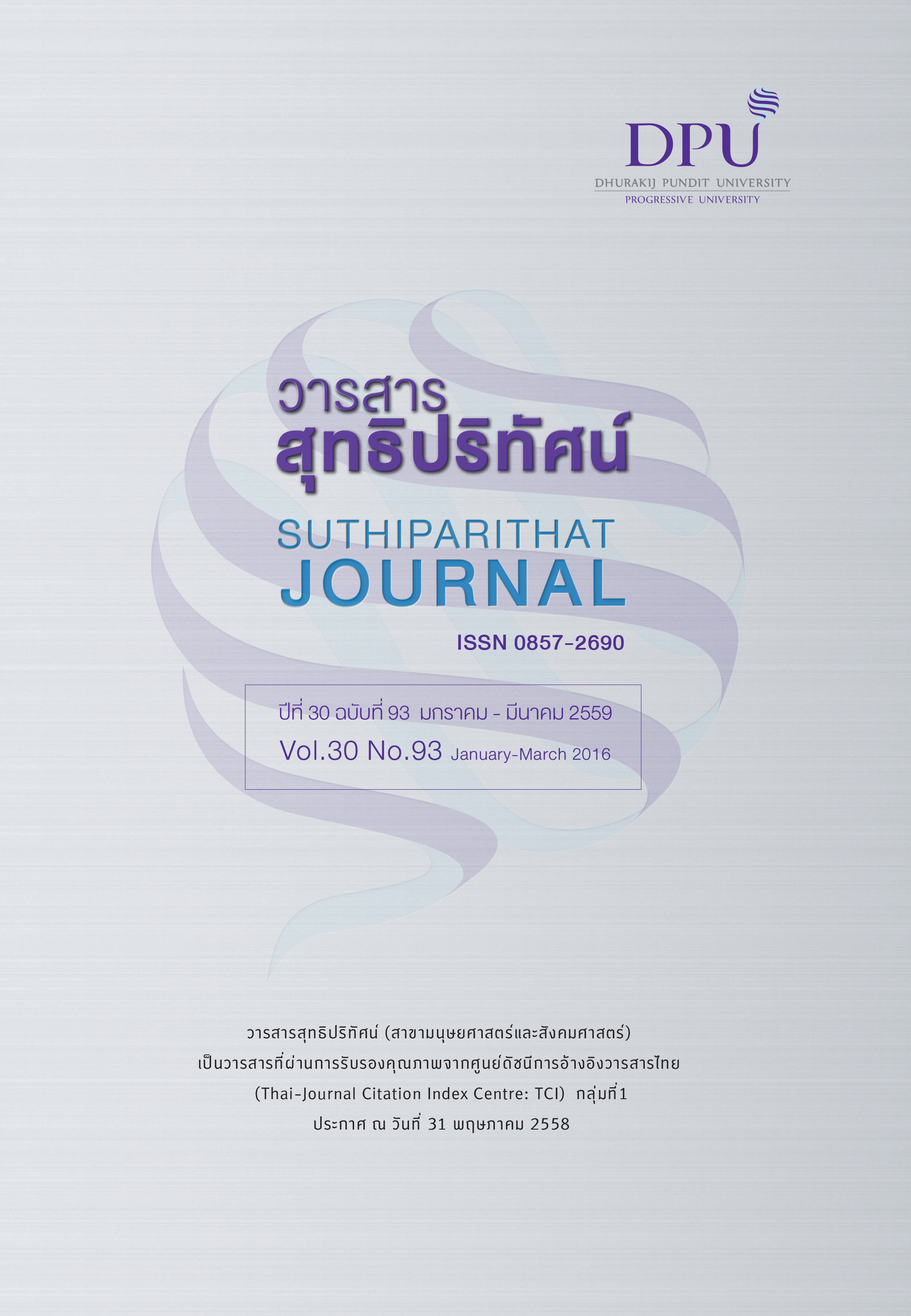PUBLIC RELATIONS CAPABILITY OF PUBLIC RELATIONS STAFF IN RAJAMANGALA UNIVERSITY OF TECHNOLOGY
Keywords:
Public Relations Capability, Public Relations StaffAbstract
The purposes of this research were to 1) study public relations capability of public relations staff (PRS) in Rajamangala University of Technology (RMUT) in the whole and in five aspects: news, speech, photography, preparation of publicity materials, and dissemination and publicity activities, 2) to compare public relations capability of PRS according to gender, age, work experience in higher education institutions, work experience in public relations, educational attainment, field of study and work agent, and 3) to compare public relations capability of PRS with a criterion. The samples used were 98 PRS of RMUT in the academic year 2015 selected by stratified random sampling and Neyman allocation. The instrument used to collect data was a Likert-type, five-point rating scale questionnaire of 32 items. The alpha reliability of the questionnaire was 0.915. The statistical methods used to analyze data included frequency, percentage, mean, and standard deviation. The hypothesis was tested by t-test for Independent samples and one-way analysis of variance at the 0.05 significant levels. The results showed that:
1. PRS in RMUT had a high level of public relations capability in the whole. When considered in each aspect, the PRS held a high level of public relations capability in the aspects of photography, the preparation of publicity materials, and the dissemination and publicity activities, but a moderate level in the aspects of news and speech.
2. There was no significant difference in public relations capability among PRS in RMUT according to their gender, age, and work experience in higher education institutions, work experience in public relations, educational attainment, and work agent in the whole and in the photography, speech, preparation of publicity materials and dissemination and publicity activities aspects. However, there was a significant difference found on the aspect of news between those who graduated in Communication Arts, Journalism, Mass Communication, and Public Relations fields and the other group that held some other major fields of study.
3. When compared public relations capability of PRS in RMUT with a criterion, there was no significant difference found in the whole. When considered in each aspect, there were two aspects , news and speed found significantly lower than the criterion and there were two espects, photography, dissemination and publicity activities found significantly higher than the criterion while the preparation of publicity materials aspect did not differ from the criterion.
References
กฤษณพงศ์ กีรติกร. (2553). วิกฤติ กระบวนทัศน์ มโนทัศน์ เพื่อการปฏิรูปการศึกษา. กรุงเทพฯ: ภาพพิมพ์.
กัญญา สิริสกุล. (2553). รายงานการวิจัย เรื่อง บทบาทของนักประชาสัมพันธ์ในประเทศไทย. กรุงเทพฯ: อัดสำเนา
กุลธิดา ธรรมวิภัชน์. (2542). ความเป็นนักวิชาชีพของนักประชาสัมพันธ์กับบทบาทและลักษณะการดำเนินงานประชาสัมพันธ์ในประเทศไทย (วิทยานิพนธ์ปริญญาดุษฎีบัณฑิต). กรุงเทพฯ: จุฬาลงกรณ์มหาวิทยาลัย.
เกรียงศักดิ์ เจริญวงศ์ศักดิ์. (2550). ทิศทางการอุดมศึกษาไทย. สืบค้น 7 มีนาคม 2558, จาก http://www.kriengsak.com/index.php?components=content&id_content_category_main=21&id_content_topic_main=36&id content_management_main=134
จุฑามาศ ลิ้มไพบูลย์. (2542). การศึกษาวิสัยทัศน์ วัตถุประสงค์และการปฏิบัติงานประชาสัมพันธ์การตลาดของนักประชาสัมพันธ์องค์กรธุรกิจในเขตกรุงเทพมหานคร (ปริญญานิพนธ์ปริญญามหาบัณฑิต). กรุงเทพฯ: มหาวิทยาลัยกรุงเทพ.
ชมพูนุท นุตาคม. (2546). สถานภาพ บทบาท และแนวโน้มการประชาสัมพันธ์ของหน่วยงานราชการและรัฐวิสาหกิจในยุคสารสนเทศ (รายงานการวิจัย). กรุงเทพฯ: สถาบันราชภัฏสวนดุสิต.
ทัณฑกานต์ ดวงรัตน์. (2553). การศึกษาเปรียบเทียบบทบาทในการปฏิบัติงานและบุคลิกภาพของนักประชาสัมพันธ์ระหว่างองค์กรภาครัฐและภาคเอกชน (ปริญญานิพนธ์ปริญญาดุษฎีบัณฑิต). กรุงเทพฯ: มหาวิทยาลัยธุรกิจบัณฑิต
เปรมศิริ นิมิตรมงคล. (2544). การประชาสัมพันธ์มุมมองของมืออาชีพ. วารสารคณะนิเทศศาสตร์มหาวิทยาลัยเซนจอห์น, 1(1), 43–47
รุจินันท์ เอื้อพิทักษ์สกุล. (2550). คุณลักษณะของนักประชาสัมพันธ์และปัจจัยที่ในการเลือกรับเข้าทำงานขององค์กรธุรกิจในประเทศไทย (ปริญญานิพนธ์ปริญญามหาบัณฑิต). กรุงเทพฯ: จุฬาลงกรณ์มหาวิทยาลัย
วัลลภา เทพหัสดิน ณ อยุธยา. (ม.ป.ป.). การอุดมศึกษา. ม.ป.พ.
พระราชบัญญัติมหาวิทยาลัยเทคโนโลยีราชมงคล พ.ศ.2548. (2548.18 มกราคม) ราชกิจจานุเบกษา. เล่ม 122 ตอนที่ 6ก. หน้า 17-27.
สำนักงานคณะกรรมการการอุดมศึกษา. (2553). ยุทธศาสตร์อุดมศึกษาไทยในการเตรียมความพร้อมสู่ประชาคมอาเซียน ในปี 2558. กรุงเทพฯ: บางกอกบล็อค.
สุรีย์พร พันพึ่ง. (2557). ภาวะเจริญพันธ์ขุ องประชาการอาเซียน. วารสารประชากรและการพัฒนา, 34(2), 1-2
อัปษรศรี ปลอดเปลี่ยว. (2543). การประชาสัมพันธ์โรงเรียน (พิมพ์ครั้งที่ 2). กรุงเทพฯ: สำนักพิมพ์มหาวิทยาลัยรามคำแหง
เอกวิทย์ แก้วประดิษฐ์. (2541). ทำไมต้องประชาสัมพันธ์สถาบันของเรา. วารสารปาริชาต, 10(2), 34-39
อุทัย ดุลยเกษม. (2556). ยุทธศาสตร์ของสถาบันอุดมศึกษาเอกชน ท่ามกลางการเปลี่ยนแปลงอย่างรวดเร็ว. วารสารเทคโนโลยีภาคใต้, 6(2), 105-109.
Cochran, W. G. (1977). Sampling Techniques (3rd ed). New York: John Wiley & Son.
Cronbach, L. J. (1984). Essential of Psychology and Education. New York: McGraw-Hill.
Downloads
Published
How to Cite
Issue
Section
License
Content and information of the article published at Suthiparithat Journal are based on the sole opinions and responsibility of author(s) only. Neither the editorial board involve in......







